Sea Urchin
 From Nwe
From Nwe | Sea urchin | ||||||||
|---|---|---|---|---|---|---|---|---|
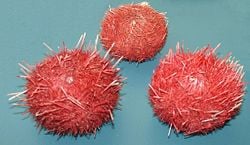
Sea urchins, Sterechinus neumayeri
|
||||||||
| Scientific classification | ||||||||
|
||||||||
|
|
||||||||
|
Sea urchin is the common name for various spiky echinoderms within the class Echinoidea, characterized by pentamerous radial symmetry; a hard calcareous shell, or test, made of regularly arranged, tightly fused plates through which rows of slender, extensible tube feet extend; movable spines covering the shell; and a mouth on the lower side, facing the substratum, with a complex chewing structure composed of five jaws (Aristotle's lantern).
In a more general sense of the term, sea urchin sometimes is used as the common name for all members of Echinoidea. However, more specifically, it is used to refer to the "regular echinoids" within subclass Euechinoidea that are pentaradially symmetrical and have their anus located on the aboral surface (opposite to the mouth). The term sea urchin, thus, does not normally include the pencil urchins in subclass Perishoechinoidea, nor the "irregular echinoids" within Euechinoidea, which include the heart urchins and sand dollars. The later tend to be characterized by a secondary bilateral symmetry and a more flattened and oval test, with very short spines, and with the anus either posterior or on the oral surface.
Sea urchins are found in oceans all over the world. They play an important role in marine food chains, consuming algae and various invertebrates, and being consumed by crabs, sea stars, fishes, mammals, and birds. When predators such as sea otters disappear from the ecosystem, the unchecked sea urchins can devastate their environment, making an "urchin barren."
For humans, sea urchins are harvested and served as a delicacy. Their roe and gonads are frequently consumed raw, or briefly cooked, with species such as the red sea urchin (Strongylocentrotus francis-canus), green urchin (S. droebachiensis), and purple sea urchin (S. purpuratus) among those favored for their roe (Freeman 2004). They are a frequent model organism for developmental and immunological studies.
Overview and description
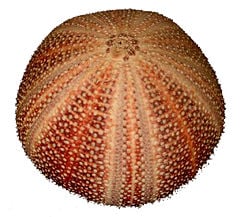
Sea urchins are members of the phylum Echinodermata, which also includes starfish, sea cucumbers, brittle stars, and crinoids. Like other echinoderms they have fivefold symmetry (called pentamerism) and move by means of hundreds of tiny, transparent, adhesive "tube feet." The pentamerous symmetry is not obvious at a casual glance but is easily seen in the dried shell or test of the urchin.
The class Echinoidea comprises sea urchins, heart urchins, sand dollars, sea biscuits, and pencil urchins. It is divided into two subclasses: Perischoechnoidea, which includes the pencil urchins (or slate-pencil urchins, with very thick, blunt spines), and Euechinoidea, which are the "true" echinoids. The true echinoids, in term, are divided into two groups: Regular echinoids (or regular urchins), which contain the sea urchins, and irregular echinoids (irregular urchins), which contain the heart urchins, sand dollars, and sea biscuits. All of these have fivefold radial symmetry (pentamerism), but the irregular urchins have secondary bilateral symmetry, with a front and back as well as a top and bottom. Also, while in the regular echinoids the anus is located in the center of the aboral surface (opposite to the mouth, on the dorsal surface), in the irregular echinoids the anus is either posterior or on the oral surface (Follo and Fautin 2001; Freeman 2004).
Sea urchins tend to be small, globular, and have their soft internal organs protected by a hard, internal, calcite shell, or test, made of plates (calcitic ossicles) fitting closely together and located under the skin. Their test is round and spiny, typically from 3 to 10 centimeters across. It tends to be arched on the aboral side (dorsal) and flat or concave on the oral side (ventral). Common colors include black and dull shades of green, olive, brown, purple, and red.
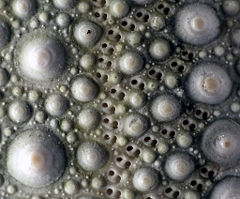
All sea urchins (indeed all echinoids) are covered by movable spines. These spines are attached to regularly arranged tubercles, which in turn are attached to the test. The spines, which in some species are long and sharp, serve to protect the urchin from predators and aid the tube feet in locomotion and digging. The spines can inflict a painful wound on a human who steps on one, but they are not seriously dangerous, and it is not clear that the spines are truly venomous. Typical sea urchins have spines that are 1 to 3 centimeters in length, 1 to 2 millimeters thick, and not terribly sharp. Diadema antillarum, familiar in the Caribbean, has thin, potentially dangerous spines that can be 10 to 20 centimeters long.
Some sea urchins also have pedicellariae between the spines, which are tiny, pincer-like structures that also can be used in defense, or for removal of unwanted parasites, detritus, or microorganisms (Freeman 2004). In some species the pedicellaria are venomous.
The test of sea urchins are pierced by pores through which extend tube feet, which are connected to the water-vascular system. These are known primarily for locomotion, but also are used to trap food, adhere to the substrate, and on the aboral side for respiration and sensation. The tube feet are slender, often sucker-tipped, and extensible.
On the oral surface of the sea urchin, facing the substratum, is a centrally located mouth made up of five united calcium carbonate teeth or jaws, with a fleshy tongue-like structure within. The entire chewing organ is known as Aristotle's lantern, which name comes from Aristotle's accurate description in his History of Animals:
…the urchin has what we mainly call its head and mouth down below, and a place for the issue of the residuum up above. The urchin has, also, five hollow teeth inside, and in the middle of these teeth a fleshy substance serving the office of a tongue. Next to this comes the esophagus, and then the stomach, divided into five parts, and filled with excretion, all the five parts uniting at the anal vent, where the shell is perforated for an outlet… In reality the mouth-apparatus of the urchin is continuous from one end to the other, but to outward appearance it is not so, but looks like a horn lantern with the panes of horn left out (Tr. D'Arcy Thompson).
Sea urchins have five pairs of gonads, whereas the irregular echinoids have between two and five (Freeman 2004).
The name urchin is an old name for the round spiny hedgehogs that sea urchins resemble.
Behavior, diet, and ecology
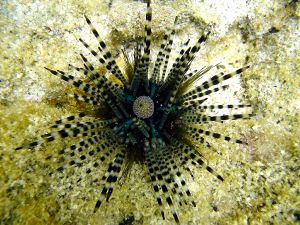
Sea urchins move slowly, with many species feeding mostly on algae. At first glance, a sea urchin often appears sessile, in other words, incapable of moving. Sometimes the most visible sign of life is the spines, which are attached at their bases to ball-and-socket joints and can be pointed in any direction. In most urchins, a light touch elicits a prompt and visible reaction from the spines, which converge toward the point that has been touched. A sea urchin has no visible eyes, legs, or means of propulsion, but it can move freely over surfaces by means of its adhesive tube feet, working in conjunction with its spines.
Sea urchins feed on algae, sea grasses, seaweeds, and a wide range of invertebrates, such as mussels, sponges, brittle stars and crinoids.
Sea urchins are eaten by crabs, lobsters, sea stars, fish, birds, otters, and other mammals (Folo and Fautin 2001). Sea urchin is one of the favorite foods of sea otters and are also the main source of nutrition for wolf eels. Left unchecked, urchins will devastate their environment, creating what biologists call an urchin barren, devoid of macroalgae and associated fauna. Where sea otters have been re-introduced into British Columbia, the health of the coastal ecosystem has improved dramatically (FOC 2004).
Geologic history

The earliest known echinoids are found in the rock of the upper part of the Ordovician period (c 450 MYA), and they have survived to the present day, where they are a successful and diverse group of organisms. In well-preserved specimens, the spines may be present, but usually only the test is found. Sometimes isolated spines are common as fossils. Some echinoids (such as Tylocidaris clavigera, which is found in the Cretaceous period Chalk Formation of England) had very heavy club-shaped spines that would be difficult for an attacking predator to break through and make the echinoid awkward to handle. Such spines are also good for walking on the soft sea-floor.

Complete fossil echinoids from the Paleozoic era are generally rare, usually consisting of isolated spines and small clusters of scattered plates from crushed individuals. Most specimens occur in rocks from the Devonian and Carboniferous periods. The shallow water limestones from the Ordovician and Silurian periods of Estonia are famous for the echinoids found there. The Paleozoic echinoids probably inhabited relatively quiet waters. Because of their thin test, they would certainly not have survived in the turbulent wave-battered coastal waters inhabited by many modern echinoids today. During the upper part of the Carboniferous period, there was a marked decline in echinoid diversity, and this trend continued into the Permian period. They neared extinction at the end of the Paleozoic era, with just six species known from the Permian period. Only two separate lineages survived the massive extinction of this period and into the Triassic: The genus Miocidaris, which gave rise to the modern cidaroids (pencil urchins), and the ancestor that gave rise to the euechinoids. By the upper part of the Triassic period, their numbers began to increase again.
The cidaroids have changed very little since their modern design was established in the Late Triassic and are today considered more or less as living fossils.
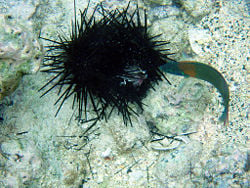
The euechinoids, on the other hand, diversified into new lineages throughout the Jurassic period and into the Cretaceous period. From them emerged the first irregular echinoids (superorder Atelostomata) during the early Jurassic, and when including the other superorder (Gnathostomata) or irregular urchins which evolved independently later, they now represent 47 percent of all present species of echinoids thanks to their adaptive breakthroughs in both habit and feeding strategy, which allowed them to exploit habitats and food sources unavailable to regular echinoids.
During the Mesozoic and Cenozoic eras, the echinoids flourished. While most echinoid fossils are restricted to certain localities and formations, where they do occur, they are quite often abundant. An example of this is Enallaster, which may be collected by the thousands in certain outcrops of limestone from the Cretaceous period in Texas. Many fossils of the Late Jurassic Plesiocidaris still have the spines attached.
Some echinoids, such as Micraster which is found in the Cretaceous period Chalk Formation of England and France, serve as zone or index fossils. Because they evolved rapidly over time, such fossils are useful in enabling geologists to date the rocks in which they are found. However, most echinoids are not abundant enough and may be too limited in their geographic distribution to serve as zone fossils.
In the early Tertiary (c. 65 to 1.8 MYA), sand dollars (order Clypeasteroida) arose. Their distinctive flattened test and tiny spines were adapted to life on or under loose sand. They form the newest branch on the echinoid tree.
Model organism
Sea urchins are one of the traditional model organisms in developmental biology. The use of sea urchins in this context originates from the 1800s, when the embryonic development of the sea urchins was noticed to be particularly easily viewed by microscopy. Sea urchins were the first species in which the sperm cells were proven to play an important role in reproduction by fertilizing the ovum.
With the recent sequencing of the sea urchin genome, homology has been found between sea urchin and vertebrate immune system-related genes. Sea urchins code for at least 222 Toll-like receptor (TLR) genes and over 200 genes related to the Nod-like-receptor (NLR) family found in vertebrates (Rast et al. 2006). This has made the sea urchin a valuable model organism for immunologists to study the development of innate immunity.
Gallery
-

Group of black, long-spined Caribbean sea urchins, Diadema antillarum (Philippi)
-

Sea urchin roe.
-
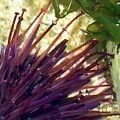
Sea urchins have adhesive tube feet.
-

Sea urchin in a reef off of the Florida coast.
-

Purple sea urchins Strongylocentrotus purpuratus in a California tide pool
-

Two Heterocentrotus trigonarius on a Hawaiian reef
References
ISBN links support NWE through referral fees
- Fisheries and Oceans Canada (FOC). 2004. Sea otter. Fisheries and Oceans Canada. Retrieved October 12, 2008.
- Follo, J., and D. Fautin. 2001. Class Echinoidea: Heart urchins, sand dollars, and sea urchins. Animal Diversity Web (online). Retrieved October 12, 2008.
- Freeman, S. M. 2004. Echinoidea. In B. Grzimek, S. F. Craig, D. A. Thoney, N. Schlager, and M. Hutchins. Grzimek's Animal Life Encyclopedia, 2nd edition. Detroit, MI: Thomson/Gale. ISBN 0787657786.
- Myers, P., R. Espinosa, C. S. Parr, T. Jones, G. S. Hammond, and T. A. Dewey. 2008. Class Echinoidea (heart urchins, sand dollars, and sea urchins). Animal Diversity Web (online). Retrieved October 12, 2008.
- Rast, J. P. et al. 2006. Genomic insights into the immune system of the sea urchin. Science 314(5801): 952-6.
- Smith, A. B., 1984. Echinoid Palaeobiology (Special topics in palaeontology). London: Allen & Unwin. ISBN 0045630011.
External links
All links retrieved January 25, 2023.
- Spiny creature's genome insight
- lantern.jpg A labeled diagram of the sea urchin's Aristotle's lantern.
Credits
New World Encyclopedia writers and editors rewrote and completed the Wikipedia article in accordance with New World Encyclopedia standards. This article abides by terms of the Creative Commons CC-by-sa 3.0 License (CC-by-sa), which may be used and disseminated with proper attribution. Credit is due under the terms of this license that can reference both the New World Encyclopedia contributors and the selfless volunteer contributors of the Wikimedia Foundation. To cite this article click here for a list of acceptable citing formats.The history of earlier contributions by wikipedians is accessible to researchers here:
- Sea_urchin history
The history of this article since it was imported to New World Encyclopedia:
- History of "Sea urchin"
Note: Some restrictions may apply to use of individual images which are separately licensed.
↧ Download as ZWI file | Last modified: 02/04/2023 02:20:21 | 6 views
☰ Source: https://www.newworldencyclopedia.org/entry/Sea_urchin | License: CC BY-SA 3.0
 ZWI signed:
ZWI signed: KSF
KSF